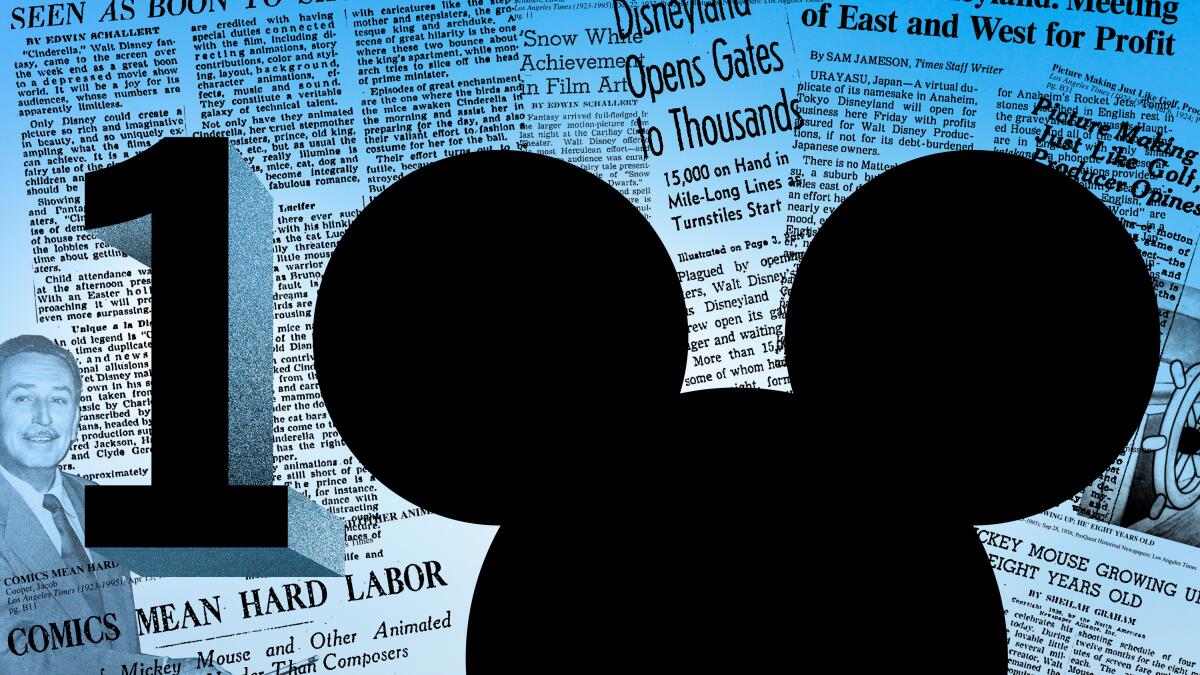Disney’s eight-minute film “Steamboat Willie” was groundbreaking. Mickey made his debut with the 1928 animated short, which also introduced synchronized sound to what had been a silent medium.
Disney pioneered sound film technology, synchronizing on-screen action with recorded speech, music and sound effects, Apgar said. The Disney studio also was the first to use a Technicolor process, and its “Flowers and Trees,” which won the 1932 Academy Award for animated short subject, was the first to bring full color to animation.
“The Disney company, under Walt, elevated animation to an art form,” art historian Heather Holian said.
When the landmark “Snow White and the Seven Dwafs” premiered at the Carthay Circle Theatre in Hollywood on Dec. 21, 1937, L.A. Times reviewer Edwin Schallert hailed the movie as an achievement in fine art. “True poetry has been achieved in this first super production,” Schallert wrote, calling it an “evocation of magic.”
The full-length animated fantasy movie adapted from the Brothers Grimm fairy tale was a big gamble for Walt Disney and his brother, Roy, who had specialized in animated shorts around the iconic Mickey Mouse and other characters. Walt took out a mortgage on his house to finance the $1.4-million picture, which was deemed by skeptics as “Disney’s Folly” during production.
Escorted by two of the seven dwarfs that appear in the picture, Shirley Temple arrives at the Hollywood premiere of “Snow White and the Seven Dwarfs” in December 1937. The showing drew a large gathering of celebrities.
(Bettmann / Bettmann Archive)
But Walt had the last laugh. The landmark film went on to receive a special Academy Award in 1939 (one regular-size Oscar along with seven dwarf Oscars) and would become one of the highest-grossing movies of its time.
“It was a stunning film that completely changed the history of animation,” Holian said. “‘Snow White’ was the first cel-animated feature-length film. It was a pivotal moment. After that, the Disney studio started to rapidly grow… and other studios had to play catch-up.”
“Snow White” ushered in a golden era of classic animated feature films, including such titles as “Pinocchio,” “Fantasia,” “Bambi,” “Sleeping Beauty” and “Peter Pan.” Disney completed the move of its headquarters to Burbank in 1940.
After stumbling in the 1970s and ’80s with some high profile flops, Disney in the Michael Eisner era enjoyed another animation renaissance with such hits as “The Little Mermaid,” “Beauty and the Beast” and the enormously successful “The Lion King,” which also inspired a popular and long-running Broadway show.
While Disney became a trailblazer in the world of animated feature films, it also faced fresh challenges from rivals that specialized in the new medium of computer-generated animation, led by Pixar Animation Studios, which transformed the industry with “Toy Story” in 1995, and DreamWorks Animation, which was led by former Disney executive Jeffrey Katzenberg and scored a massive hit with “Shrek.”
Pixar’s then-creative guru John Lasseter was a former Disney animator who was inspired by Disney’s innovative use of CGI in the sci-fi movie “Tron.” And Disney, which distributed Pixar films, recognized the power of those franchises, leading to its $7.4-billion deal in 2006 to acquire the Emeryville, Calif., studio.
“It was the mark of a new era,” said Holian, who teaches a class called Art of Disney and Pixar at the University of North Carolina at Greensboro. “They saw these films were resonating with the same audience groups that Disney was after.”
From theme parks to animation and kids’ programming, the Walt Disney Co. has revolutionized the entertainment business since its launch a century ago. Read More

